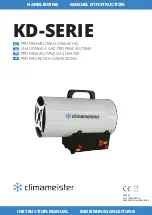
57
Note: Do not remove the compression fitting cap nut. This could allow the thermistor
to become free and possibly fall into the tank.
7.
Using the correct size six (6) point socket, remove the body of the compression
fitting from the tank. The remainder of the wires, still in the compression fitting,
as well as the thermistor will come out of the tank with the compression fitting
body.
8.
Verify that the new thermistor is rated the same as the one that is being replaced.
9.
Carefully configure (bend) the wires to allow the thermistor to be inserted into the
tank. In addition, to insure proper positioning of the thermistor, straighten the
wires in the area where they meet the thermistor.
10.
Insert the thermistor into the tank and start the compression fitting body into the
threads. Follow recommendations contained in the manufacturer's documentation,
local codes, or accepted contractor practices as to the use and / or type of joint
compound or sealer at the connections.
11.
Tighten the body of the compression fitting with the correct size
wrench
. A
socket can not be used to tighten the fitting because of the wires attached to the
thermistor.
Do not tighten the compression fitting cap nut
.
12.
Gently withdraw any extra length of the wires from the tank, pulling the thermistor
so that 1" of the probe is exposed on the outside of the fitting.
Note: If the thermistor is not correctly positioned in the tank (i.e. it is allowed to
droop) it will not correctly sense the water temperature at the level of the
heating elements.
13.
Slide the compression ring into place against the compression fitting body and
tighten the cap nut with the appropriate size wrench.
14.
Reconnect the wires to the step controller, checking to assure that they are
attached in the same position from which they were removed.
15.
Refill the tank with water, examining the compression fitting area for any signs of
leakage.
16.
If no leakage is detected, reposition any fiberglass insulation that was moved to
provide access to the compression fitting.
17.
Follow the start up procedures on page 17 to return the unit to operation.
Summary of Contents for EHB
Page 41: ...38 ...
Page 62: ...59 9 If no leaks are found follow the startup procedures page 17 to put the unit back on line ...
Page 64: ...61 Appendix A cont d ...
Page 65: ...62 Appendix A cont d ...
Page 68: ...65 ...









































